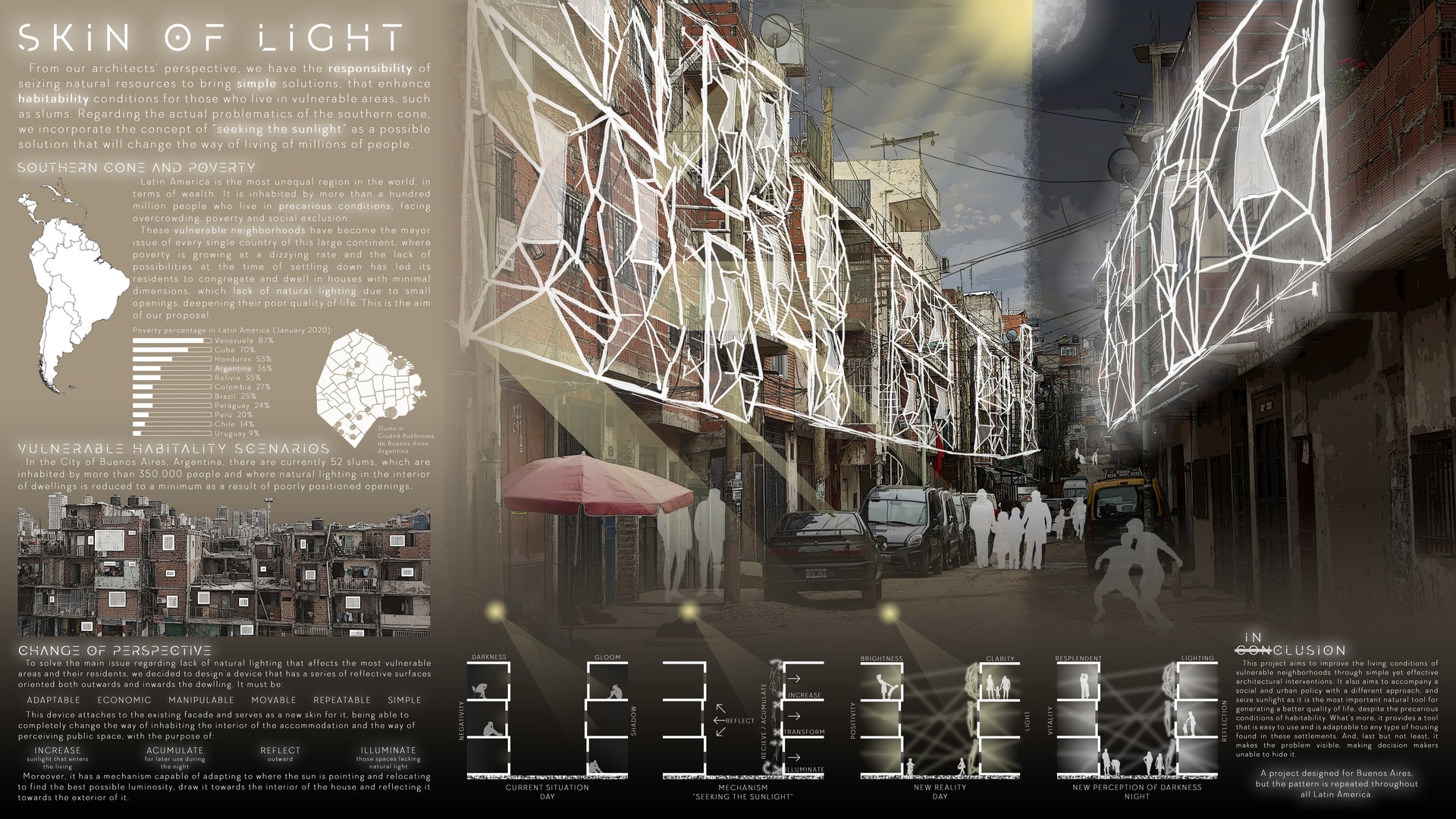Project Description
SKIN OF LIGHT From our architects’ perspective, we have the responsibility of seizing natural resources to bring simple solutions, that enhance habitability conditions for those who live in vulnerable areas, such as slums. Regarding the actual problematics of the southern cone, we incorporate the concept of “seeking the sunlight” as a possible solution that will change the way millions of people live. SOUTHERN CONE AND POVERTY Latin America is the most unequal region in the world in terms of wealth. It is inhabited by more than a hundred million people who live in precarious conditions, facing overcrowding, poverty and social exclusion. These vulnerable neighborhoods have become the major issue of every single country of this large continent, where poverty is growing at a dizzying rate and the lack of possibilities when settling down has led its residents to congregate and dwell in houses with minimal dimensions, which lack of natural lighting due to small openings, deepening their poor quality of life. This is the aim of our proposal. Nowadays, poverty in countries such as Venezuela and Cuba has escalated to more than 80% and 70%, while, with few exceptions, the rest of the southern cone countries which have tens of millions of inhabitants, poverty rates are about 20% and 30%. VULNERABLE HABITABILITY SCENARIOS In the City of Buenos Aires, Argentina, there are currently 52 slums, which are inhabited by more than 350.000 people and where natural lighting in the interior of dwellings is reduced to a minimum as a result of poorly positioned openings. CHANGE OF PERSPECTIVE To solve the main issue regarding lack of natural lighting, affecting the most vulnerable areas and their residents, we decided to design a device that has a series of reflective surfaces oriented both outwards and inwards. This device, which has a simple design which can be repeated and installed on each facade, adapts to windows with minimal dimensions, and can be manipulated and moved to orientate and find the best possible lighting. It is also made with economic materials, which are indigenous to the region. This device attaches to the existing facade and serves as a new skin for it, being able to completely change the way of inhabiting the interior of the accommodation and the way of perceiving public space. Our device aims to increase the amount of light that floods the housing interiors, accumulate it for later use during the night, reflect it towards houses at the opposite side of the road in order to illuminate those spaces that lack natural lighting. Moreover, it has a mechanism capable of adapting to where the sun is pointing and relocating to find the best possible luminosity, draw it towards the interior of the house and reflecting it towards the exterior of it. CONCLUSION This project aims to improve the living conditions of vulnerable neighborhoods through simple yet effective architectural interventions. It also aims to accompany a social and urban policy with a different approach, and seize sunlight as it is the most important natural tool for generating a better quality of life, despite the precarious conditions of habitability. What’s more, it provides a tool that is easy to use and is adaptable to any type of housing found in these settlements. And, last but not least, it makes the problem visible, making decision makers unable to hide it. “A PROJECT DESIGNED IN BUENOS AIRES, BUT A PATTERN REPEATED THROUGHOUT ALL LATIN AMERICA.” The main drive that led us to designing this proposal was finding a way to draw more natural lighting into the interior of accommodations which don’t have the capacity to do so. However, we know the implications of the studies done on natural lighting related to urban environments. We are fully aware that is not easy to classify our proposal into just one category, but we decided to categorize it into “Daylight in Buildings”, as the quality of interior spaces is the main focus of our proposal.
